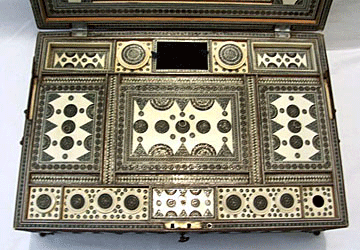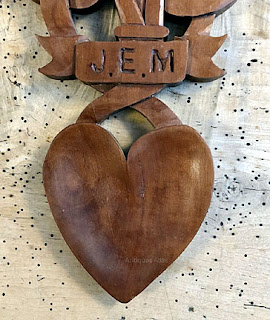QUESTION: Recently, as I was browsing the tables at a local garage sale, I came across a unique box covered with tiny bits of stone in intricate geometric patterns. I asked the homeowner if they knew anything about it, but she said she bought it several years ago at another yard sale. I decided to buy the box but I can’t find anything about it. What can you tell me about this box?
ANSWER: Your box is an example of a Sadeli Mosaic, a type of decoration of repeating geometric patterns on a variety of boxes, card cases, and chess boards produced in India since the 16th century. Becoming popular in the 19th century, it’s a type of micro mosaic. Since Bombay (now Mumbai) became a center of making them, they became known as Bombay boxes.
Archaeologists believe the ancient art of Sadeli Mosaic first appeared in Shiraz in Persia by way of Sind to Bombay, a long time before Indian boxes appeared. The designs on early boxes look deceptively simple. They emerged from a culture which had mastered geometry and understood how to generate a pattern from a set number of points. The patterns are so harmoniously combined that their incredible complexity isn’t immediately apparent to the viewer.
While the technique may at first seem exquisitely complex, it’s relatively simple. Nevertheless, it required a great deal of skill and patience.
 The first step in creating a Sadeli mosaic was to prepare thin rods by scraping lengths of ivory, bone or wood into the desired shape, usually triangular. Artisans then glued these long thin rods together with animal glue, then sliced them transversely to form a repeat pattern. To get variety and contrast, they used woods like ebony and rosewood, along with natural and green-stained bone and ivory. Often they mixed in circular shaped rods of silver, pewter or tin. Finally, they glued the slices onto the surface of a wooden box, often made of sandalwood. Craftsmen then scraped the surface of the slices to level slight variations. To achieve variations of patterns, they combined the materials in different ways.
The first step in creating a Sadeli mosaic was to prepare thin rods by scraping lengths of ivory, bone or wood into the desired shape, usually triangular. Artisans then glued these long thin rods together with animal glue, then sliced them transversely to form a repeat pattern. To get variety and contrast, they used woods like ebony and rosewood, along with natural and green-stained bone and ivory. Often they mixed in circular shaped rods of silver, pewter or tin. Finally, they glued the slices onto the surface of a wooden box, often made of sandalwood. Craftsmen then scraped the surface of the slices to level slight variations. To achieve variations of patterns, they combined the materials in different ways.
Persian and Indian makers of this exquisite decorative technique displayed an understanding of the qualities of the different materials they used. They combined substances, which could expand and contract according to atmospheric conditions with others which were hard and unyielding. The result was a sharp definition of the lines and patterns which made up the whole design.
 Beginning in the early part of the 18th century, Indian artisans made what came to be known as Anglo-Indian boxes for the English residents living in India, who eventually brought or sent them back to England. At the beginning of the 19th century, India began exporting these boxes commercially, although not in any significant numbers until the 1850s. People valued them so highly that manufacturers of biscuit tins copied the designs on them in the late 19th and early 20th century.
Beginning in the early part of the 18th century, Indian artisans made what came to be known as Anglo-Indian boxes for the English residents living in India, who eventually brought or sent them back to England. At the beginning of the 19th century, India began exporting these boxes commercially, although not in any significant numbers until the 1850s. People valued them so highly that manufacturers of biscuit tins copied the designs on them in the late 19th and early 20th century.
 Anglo-Indian boxes fall into four groups: Rosewood or ebony boxes inlaid with ivory; sandalwood boxes veneered in ivory, tortoiseshell, horn, quills or a combination of these materials; sandalwood boxes covered with Sadeli mosaic; and carved boxes often combined with Sadeli mosaic.
Anglo-Indian boxes fall into four groups: Rosewood or ebony boxes inlaid with ivory; sandalwood boxes veneered in ivory, tortoiseshell, horn, quills or a combination of these materials; sandalwood boxes covered with Sadeli mosaic; and carved boxes often combined with Sadeli mosaic.
The first two categories came from Vizagapatam in East India while the last two came from Bombay in West India.
English traders discovered the rich woods and intricate workmanship of Indian artisans, so colonial government officials began to recognize the work of the Indian artists and craftsmen as a source for satisfying the need for furniture and boxes, which would both serve to enhance English households in India. This gave rise to the cabinetmaking workshops in Vizagapatam between Calcutta and Madras.
 Craftsmen made the first boxes to be decorated with Sadeli Mosaic of rosewood or ebony with ivory, incised to give further definition to the decoration, directly inlaid into the wood. The shape of the early boxes was either sloping at the front with a flatter section at the back, reminiscent of English writing slopes, or rectangular. Artisans inlaid the borders with stylized floral scrolls and the centers with a single floral motif following a circular or oval symmetrical or asymmetrical pattern. The edging was of ivory pinned with ivory pins, or a combination of ivory and wood. Both ornamental and protective, both helped protect the end grain against the weather.
Craftsmen made the first boxes to be decorated with Sadeli Mosaic of rosewood or ebony with ivory, incised to give further definition to the decoration, directly inlaid into the wood. The shape of the early boxes was either sloping at the front with a flatter section at the back, reminiscent of English writing slopes, or rectangular. Artisans inlaid the borders with stylized floral scrolls and the centers with a single floral motif following a circular or oval symmetrical or asymmetrical pattern. The edging was of ivory pinned with ivory pins, or a combination of ivory and wood. Both ornamental and protective, both helped protect the end grain against the weather.
 The style of the ornamentation on the early boxes was formal yet flowing and robust, a perfect compliment to the strength and grain of the rosewoods. The boxes often had silver escutcheons and drop handles. Indian artisans made this type of box up to the 1750s.
The style of the ornamentation on the early boxes was formal yet flowing and robust, a perfect compliment to the strength and grain of the rosewoods. The boxes often had silver escutcheons and drop handles. Indian artisans made this type of box up to the 1750s.
They also made ivory inlaid boxes in more conventional English shapes, such as writing, document, and jewelry boxes later in the 18th and 19th centuries. The designs by this time had moved on to covering more of the box in an integrated pattern or with a simple edge decoration with a small central motif.
 In the early boxes, which date from the turn of the 18th to the 19th century, there are large panels of mosaic covering the tops and sides. It took incredible skill to cover such large areas without any wavering of the pattern. To further enhance the symmetry of these boxes, artisans impeccably matched the corners and where the sides joined the bottom.
In the early boxes, which date from the turn of the 18th to the 19th century, there are large panels of mosaic covering the tops and sides. It took incredible skill to cover such large areas without any wavering of the pattern. To further enhance the symmetry of these boxes, artisans impeccably matched the corners and where the sides joined the bottom.
To meet the demand, additional Indian workshops began making Sadeli Mosaic boxes in the latter part of the 19th century. The accuracy of execution and the sharpness of design suffered, however, although boxes from this period are pretty and easier to find.
 The majority of the boxes found in the antiques market today are from the early to mid 19th century. By the 1820s, Indian craftsmen covered few boxes completely in Sadeli Mosaic, using it more sparingly combined with other materials, mainly ivory. Latter sandalwood boxes, veneered in ivory, had circles, diamonds or bands of mosaic inserted as further decoration.
The majority of the boxes found in the antiques market today are from the early to mid 19th century. By the 1820s, Indian craftsmen covered few boxes completely in Sadeli Mosaic, using it more sparingly combined with other materials, mainly ivory. Latter sandalwood boxes, veneered in ivory, had circles, diamonds or bands of mosaic inserted as further decoration.
To read more articles on antiques, please visit the Antiques Articles section of my Web site. And to stay up to the minute on antiques and collectibles, please join the over 30,000 readers by following my free online magazine, #TheAntiquesAlmanac. Learn more about "The Roaring Twenties" in the 2025 Spring Edition, online now. And to read daily posts about unique objects from the past and their histories, like the #Antiques and More Collection on Facebook.
















































